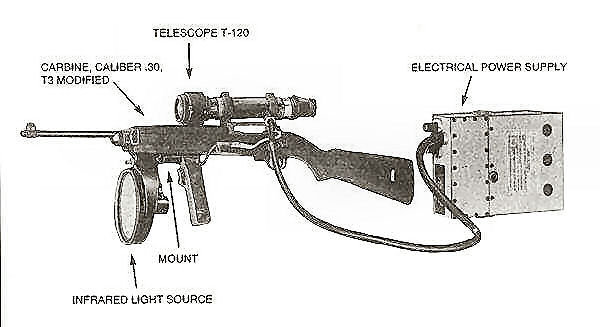The US Carbine, Caliber .30in, M3, or T3, was an M2 with suitable mountings prepared on the receiver to take various models of infra-red night-sighting devices. No open or conventional sights were provided. The M3, (its development title was T3), was produced in limited numbers as a semi-prototype. Only about 2100 were manufactured compared to 5,510,000 M1 carbines, 150,000 M1A1 carbines and 570,000 M2 carbines.
These infrared weapons were developed in 1943 by the Army, precisely to defeat the infiltration tactics of the Japanese. Although fewer than 500 units were actually used, the Sniperscope accounted for about 30% of total Japanese casualties suffered by small-arms fire during the first week of the Okinawa campaign.
Few combat personnel in the Korean War were aware that the US possessed infrared night-vision capability. Those who did know, didn't welcome them. Objections were mostly focused on their bulk and susceptibility to damage.
In part, the poor reception by combat units of night vision weapons was because the Sniperscope M1 did indeed have significant flaws. However, the vastly improved Sniperscope M3, with almost double the effective range of the M1, with a less vulnerably located IR light source, and with the T23 flash hider was available at about the start of the Korean War. Supplying only the M3, and in quantity, would have made the value of the weapon much more obvious, particularly if done before we faced the CCF.
In actuality, all these infrared devices would have been of tremendous value, if provided in sufficient quantities and with personnel trained in their use distributed along perimeter defenses and listening posts. The main strengths of the Chinese forces were their ability to move swiftly at night, locate automatic weapons and unit defensive weak points, move grenade and submachine gun platoons into striking range by stealth, and then attack violently without warning. Clearly, night-vision weapons distributed among rifle squads in perimeter defenses would have been decisive weapons. Their weakest feature was their active source, that is they illuminated the search areas, albeit with IR. Once an enemy had reason to anticipate their use, they could have used IR detectors and located the source from much further distance than the range of Sniperscope itself, enabling very effective counter measures !
To me, the US Army higher command levels failed abysmally in Korea.
First, they failed to prepare our ground forces psychologically for the savage realities of infantry combat. Instead, they prepared our combat units basically for nothing but garrison duty. Secondly, they initially failed to equip all our infantry with the 3.5 inch superbazooka and HEAT rounds, to effectively cope with modern armor, even though these had been made standard shortly after WWII. Finally, they failed to introduce reliable small-unit communications equipment, and special weapons such as infrared night-vision carbines, even though these would have given us a decisive edge in small-unit combat at night.
These blunders are consistent with High Command's lack of understanding of the tactics and strengths of the North Koreans, and of the CCF itself. Together, these blunders of command were primarily responsible for our initial defeats by the North Koreans, and for our later crushing defeats by the CCF. These deficiencies were largely corrected over time, and we did force the Chinese and NK to the truce table, but the men who paid were those who were killed, wounded or imprisoned, not the higher command levels actually responsible for the blunders.


